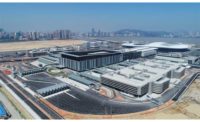Island & Tunnel Project of Hong Kong-Zhuhai-Macao Bridge
Zhuhai City, China
Best Projects
Owner Hong Kong-Zhuhai-Macao Bridge Authority
Lead Design Firm China Communications Construction Co.
General Contractor China Communications Construction Co. Project Management Dept.
Engineers AECOM Asia Co. and COWI A/S Denmark
The concept of connecting Zhuhai, Hong Kong and Macao has been talked about since the 1980s. The islands, bridge and tunnel will slash travel times by roughly three hours and 30 minutes, but crossing the physical barriers of the Pearl River Delta and the South China Sea is an engineering challenge like no other.
The 4.1-mile tunnel is the world’s longest immersed road tunnel and carries six lanes of traffic to artificial islands between Hong Kong and the bridge that leads to Zhuhai and Macao, all of which crosses a portion of the South China Sea. The island and tunnel portion of the project is a marvel of pre-cast concrete construction, with 33 tunnel elements (hollow concrete and steel shells) built in a factory.
Each tunnel piece measures 590 ft by 125 ft by 37 ft and weighs a staggering 80,000 tons. At its deepest point, the tunnel is immersed 157 ft beneath the South China Sea.
Construction crews precast each element on Guishan Island, near Zhuhai, and transported them to the site by tugboats. A foundation trench in the seabed was created by general contractor China Communications Construction Co., and the massive elements—including five curved ones—arrived and were immersed into place. Gao Xinglin, assistant director and senior engineer for owner Hong Kong-Zhuhai-Macao Bridge Authority, said the concrete exteriors of the elements are “proactive water sealing closure joints,” meaning that, upon installation, all connections become waterproof. There is a 7,165-ton butt joint in the middle of the tunnel.
China Communications Construction led the joint venture engineering effort with Denmark’s COWI providing immersed tunnel expertise. Challenges included soft soil that complicated the placement of the rock bed and the sheer scale.
Artificial islands were built on each end of the tunnel in shallower waters.
China Communications Construction used a structural frame built from 120 hollow steel caissons 165 ft high and weighing 550 tons each. They were prefabricated in Hong Kong and hammered into place on site, with the islands and the buildings on them built around the supports.








Post a comment to this article
Report Abusive Comment